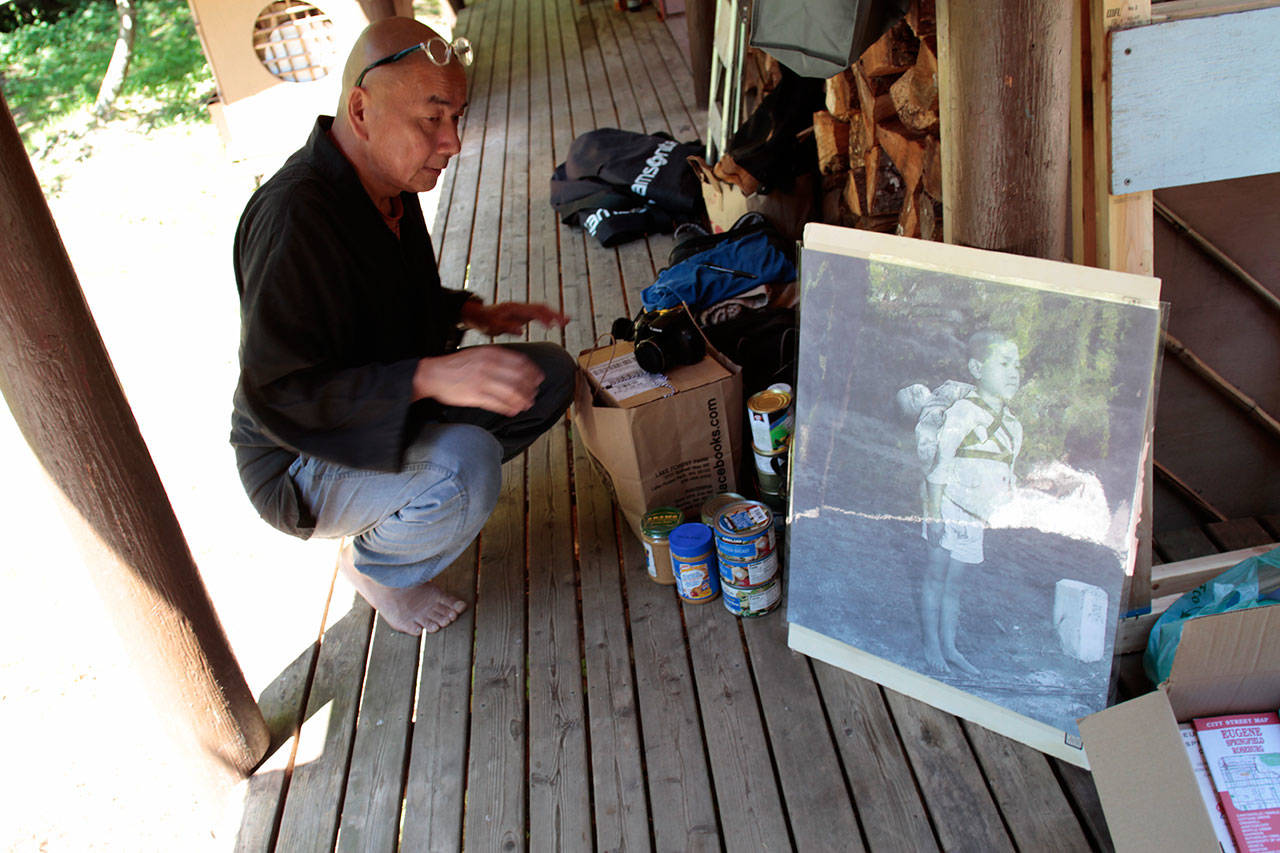In 1965, protestors walked in Alabama around the clock for three days in the Selma to Montgomery March, enduring deadly violence on the part of local authorities and racist vigilantes to bring worldwide attention to the difficulties faced by black voters, and the need for a national Voting Rights Act.
In 1973, a disillusioned young man, Peter Jenkins, set out to walk across America, “searching for myself and my country.” He found friendship, adventure, tragedy and inspiration: His bestselling book recounting the experience was one of the first tomes to popularize adventure travel.
In 1974, filmmaker Werner Herzog trekked from Munich to Paris in the dead of winter to visit his close friend, German film historian Lotte H. Eisner, who was dying. He believed that an act of walking there would keep Eisner alive. She lived until 1983.
Now, in 2018, Reverend Senji Kanaeda, of the Nipponzan Myohoji Buddhist Temple of Bainbridge Island, will lead an interfaith peace walk from Eugene, Oregon to Seattle — about 283 miles — espousing the need to remove nuclear weapons from the world.
This, the 14th annual Pacific Northwest Interfaith Peace Walk, began in Oregon on Thursday, July 26, and will stop in cities in both states for participants to gather, demonstrate and rally for their peaceful cause.
The theme this year is: “No More War – A World Without Nuclear Weapons.”
“Participants will walk from 11 to 13 miles each day,” said Leonard Eiger, the event spokesman and Ground Zero Center for Nonviolent Action’s Communications co-chairman. “People are welcome to join in for an hour, a day, or more, or speak at evening potluck dinners.”
Ground Zero is one of several activist groups supporting and taking part in this year’s walk.
People of all faiths are welcome, Eiger said.
In Washington, participants will attend several events commemorating the atomic bombings of Hiroshima and Nagasaki, including Ground Zero Center for Nonviolence Action’s weekend of remembrance and action from Saturday, Aug. 4 through Sunday, Aug. 6, and the “Hiroshima to Hope” lantern ceremony at 6 p.m. at Seattle’s Green Lake on Aug. 6.
It is, reportedly, one of the largest such ceremonies in the world, outside of Japan.
The annual peace walk also has strong ties with the Marshallese community of Salem, Oregon.
The Marshall Islands (officially, the Republic of the Marshall Islands) is an island country near the equator in the Pacific Ocean. During World War II, the United States took control of the islands and conducted nuclear testing there from 1946 until 1958. Many Marshall Islanders were displaced by the testing, which made parts of their homeland unsafe.
“They became a victim of the hydrogen bomb tests,” Kanaeda said.
Though everyone knows of the destruction wrought on Japan through the infamous bombings of Hiroshima and Nagasaki, Kanaeda said lesser-known stories, like those of the Marshall Islands, and non-military related incidents, like the Three Mile Island accident and the Chernobyl disaster, are as much a point of focus for anti-nuclear weapons protesters as the more iconic instances.
“It’s related to the Japanese peace movement, our movement,” he said. “[In] 1945 we had Hiroshima and Nagasaki experience. But except for Hiroshima and Nagasaki people, Japanese people don’t know so much about the destruction and radiation because in the American occupation time they hid those kind of truths.”
Walking protests have a long, proud history among those of the Buddhist faith.
“Our Buddhist order started to walk from Tokyo to Hiroshima in 1958, and continue now because still we have a lot of nuclear weapons,” Kanaeda said.
The walk takes place at perhaps the hottest time of the year — a deliberate choice Kanaeda, a longtime participant, said has only become more significant as climate change discourse has gained worldwide attention.
“It’s the hottest time, even here,” he said. “Not as hot [as in] Arizona, but very hot. It’s not exactly a sacrifice, because nobody asked us to do it. We just do it. Maybe this is just a ripple, one drop in the Pacific Ocean, but whatever we can do we want to do.”
Having himself walked every year since 2005, Kanaeda said it’s only gotten hotter.
“[It’s] much hotter than before,” he said. “Used to be, we’d never have 105 [degrees] or something on the way.”
Kanaeda is a familiar fixture on Bainbridge, seen often walking along the island’s busiest byways, usually keeping pace with steady, rhythmic drumming.
He walks to meditate and for his health, he said, though he doesn’t do more or less in the days before the peace walk, figuring he’s already as ready as he’ll ever be.
About 2,000 people are expected to walk the entire way, Kanaeda said, arrangements having been made for them to sleep in various churches and schools. Many more come for shorter legs in each city.
“[It] used to be we walked a lot, maybe at least 15, 16, 17 miles a day, every day,” Kanaeda said. “But this time [it is] only Tacoma [that] is a little bit longer and [it’s] basically 12 miles [a day].
“In each city or each community we have a kind of gathering and program on this particular walk,” he added.
Gathering spots on this year’s walk include Eugene, Corvallis, Salem, Portland, Olympia, Tacoma, Bainbridge Island, Suquamish, Poulsbo, and Seattle.
The Bainbridge-based leg begins at 9 a.m. Friday, Aug. 3 at the Nipponzan Myohoji Buddhist Temple (6154 Lynwood Center Road NE). Marchers will walk along Day Road, Highway 305 up to Seabold Methodist Church to Agate Pass Bridge, then on to Chief Seattle’s grave, then Suquamish UCC Church (18732 Division Ave. NE).
For a complete walk timeline and schedule of events, visit www.nipponzan.org.



